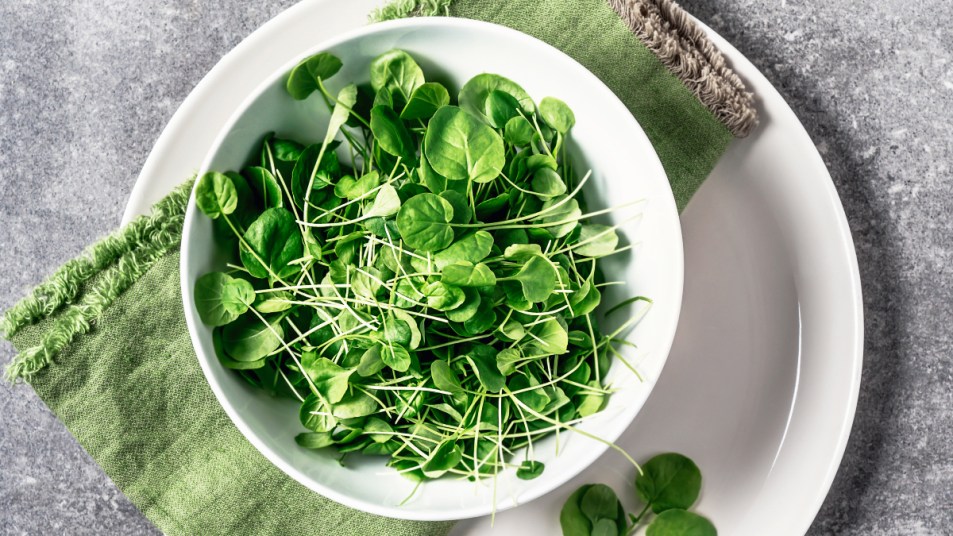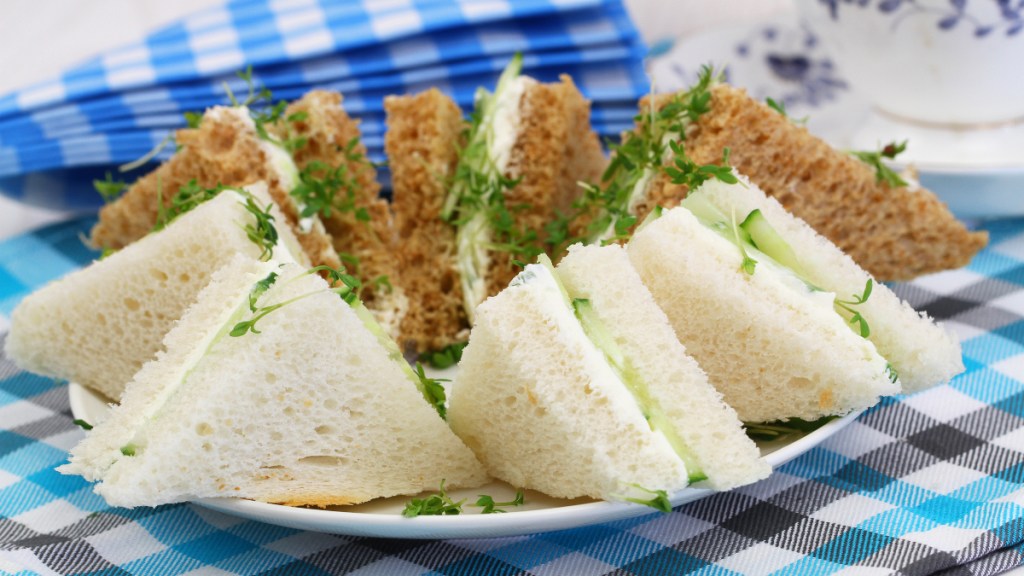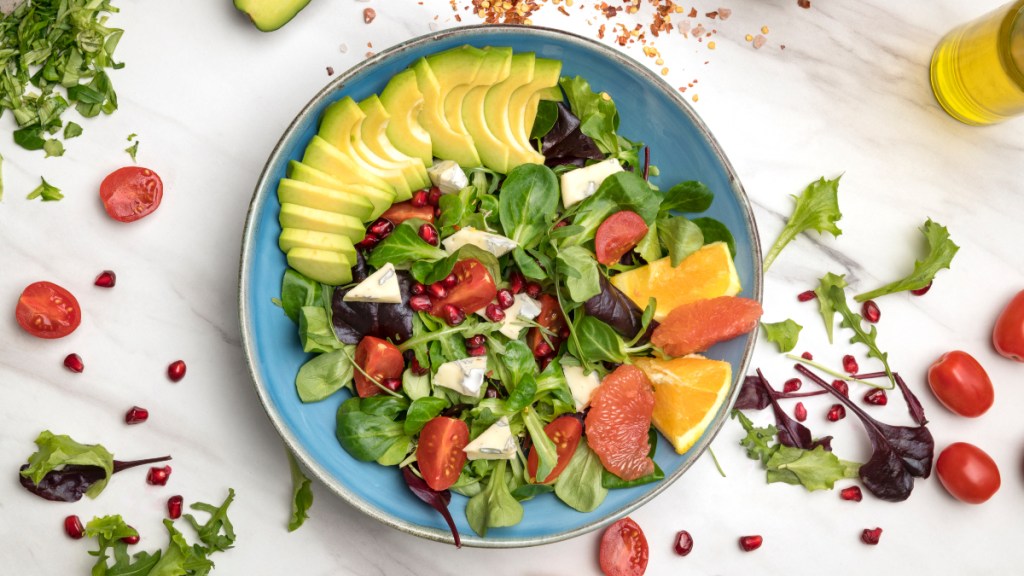Watercress Is the World’s Top Superfood You Didn’t Know You Needed
It helps quash cravings, protect vision and ward off cancer. No wonder it's been dubbed the healthiest food!

Watercress is more than a pretty garnish. This often-overlooked cruciferous vegetable is not only low in calories, but also chockful of vital nutrients that support cardiovascular, bone and eye health. It may even help protect against certain types of cancer. Here, experts give the lowdown on this leafy green, how to eat it, and five powerful health benefits of watercress you’ll want to know about.
What is watercress?
Watercress, also known as Nasturtium officinale, is an aquatic plant. It belongs to the mustard (Brassicaceae) family, which also includes leafy and cruciferous vegetables such as collard greens, cauliflower, broccoli and Brussels sprouts. It’s recognizable by its small, glossy, rounded green leaves attached to hollow, pale green stems. Watercress boasts a peppery flavor and fresh leafy scent, similar to that of arugula.
Historically, watercress has been around for 3,000 years since originating in ancient Greece. It was used for culinary and medicinal purposes by the Greeks, Romans and Persians, who believed it would help cure mental health issues, blood disorders, and even baldness. Native Americans also used watercress as a food source (it’s recorded as being on the first Thanksgiving menu) and to treat kidney and liver illnesses and dissolve gallstones.
Watercress is especially popular in England, and has been since Victorian times. “When watercress comes to mind, people often associate it with classic British fare like watercress soup and watercress sandwiches served during traditional high tea,” says Sonali Ruder DO, a culinary physician in Delray Beach, FL, and author of The Foodie Physician Cookbook. “It has a long culinary history in England.”

But watercress is definitely garnering more attention these days, especially for its high nutrient value. A Centers for Disease Control and Prevention (CDC) ranked watercress as the number one most nutrient-dense fruit or vegetable. It achieved a perfect score of 100, beating out other top superfoods such as spinach, kale, and chard.
What makes watercress so healthy
“Watercress boasts numerous health benefits, making it a valuable addition to your diet,” says Dr. Ruder. “It’s is packed with a multitude of vitamins, minerals, and antioxidants and is particularly high in vitamins K, C and A, calcium, potassium and magnesium.”
Other beneficial watercress components include phosphorus, iron, folate, and protein. What’s more, the leafy green is low-carb, low-calorie, and water-rich, making it ideal for weight loss, digestion, and gut health.
5 health benefits of watercress
So just what can this humble veggie do for you? Here, we dive into the top health benefits of watercress.
1. It keeps you feeling fuller longer
One cup of chopped watercress clocks in at less than 4 calories, plus the veggie is fat-free. That makes it a smart pick for filling up without derailing your healthy eating habits.
“When it comes to weight loss or management, you want to outsmart your stomach,” says Joan Salge Blake, RDN, EdD, a registered dietitian and a clinical professor of nutrition at Boston University’s Sargent College of Health and Rehabilitation Sciences. “Your stomach likes to be full and the best way to fill it up is to add more fiber-rich veggies at mealtime. If you pile watercress onto a chicken or turkey burger along with lettuce, avocado and tomatoes, the more satiated you’re going to be.” The result: Your stomach stays fuller (and happier), which makes you less likely to overindulge.
2. It safeguards your sight
Watercress contains lutein and zeaxanthin, two key nutrients that are essential for eye health. Lutein and zeaxanthin are antioxidants that protect the retina, the light sensitive layer of tissue at the back of the eye. How? They filter out damaging blue light and ward off free radical damage in the eye. What’s more, a study in Nutrients suggests the duo is linked with a reduced risk of vision-robbing age-related macular degeneration (AMD) and cataracts. (Click through to learn the early warning signs of macular degeneration — plus how to keep your vision sharp.)

3. It strengthens your bones
Watercress is rich in vitamin K, which is crucial for bone health, says Jill Carnahan, MD, a functional medicine and family physician in Louisville, CO, and author of Unexpected: Finding Resilience through Functional Medicine, Science, and Faith. “Vitamin K, along with vitamin D, work together along with other nutrients to maintain bone health,” she explains. “If you don’t have enough vitamin K, you’re more prone to osteoporosis.”
That’s because vitamin K helps make proteins in the bone that are essential for bone regulation and resorption. In fact, a study in Medicine found people with a higher daily intake of vitamin K had a lower risk of bone fractures than people who got less of the nutrient. (Click through for more ways to strengthen your bones so you can avoid osteoporosis drugs.)
4. It protects your heart
Adding watercress to your diet can do your heart good. Research in the Journal of the American Heart Association shows eating cruciferous vegetables on a regular basis protects against plaque build-up in the arteries, thanks to the veggies’ phytochemicals.
Another heart protective element of watercress and leafy greens is their high nitrate content. Nitrates are absolutely crucial to make nitric oxide in our bodies, says Dr. Carnahan, who is also the host of the Resiliency Radio podcast. “Nitric oxide opens and dilates the blood vessels,” she explains. “This improves blood flow and decreases blood pressure, helping lower the risk of heart disease.”
5. It helps prevent cancer
“Watercress, like other cruciferous vegetables, is rich in glucosinolates, which are activated into isothiocyanates, compounds that have been shown to prevent colon, lung, prostate, breast, and skin cancers,” says Dr. Ruder.
Research suggests watercress increases antioxidants in the blood and protects against cell damage, which may counteract certain processes by which cancers grow and spread. Further proof of its protective powers: A study in The American Journal of Clinical Nutrition found eating watercress was linked to a reduction in cancer risk. Folks who ate 85 grams of watercress daily for 8 weeks had a lower chance of developing cancer. Carotenoids found in watercress protect cells against lymphocyte DNA damage, which can lead to cancer development and progression.
For more on the health benefits of watercress, check out the video below from Eric Berg, DC.
How to get the health benefits of watercress
Whether you enjoy it raw or cooked, watercress is easily incorporated into meals for a flavorful, nutrient-dense kick.
“Watercress has a unique taste and adds to everything, it’s a pretty versatile flavor enhancer,” says Salge Blake. “You can use watercress in stir fries, soups, and stews, as a topping for a burger and as a garnish for fish, chicken or beef. When you put watercress on top of something, it’s a very pretty look and people tend to eat with their eyes. You almost know you’re going to like it because it looks so beautiful,” she adds.
Dr. Ruder suggests adding watercress to scrambled eggs, omelets and frittatas, blend it into a smoothie with some sweet fruit to balance out the peppery taste, or toss into salads with other leafy greens and veggies.
“Salads are such a common thing to make and it’s easy to get in the habit of using the same lettuce,” says Dr. Carnahan. “But throwing in greens you don’t normally eat, like watercress, shakes things up a bit without drastically changing the flavor or taste. Leafy greens consistently come out as crucial to our health because they contain so many vitamins.”
Rainbow Superfood Salad
Getting the health benefits of watercress is easy, thanks to this colorful (and flavorful!) salad recipe from Dr. Ruder.

Ingredients:
- 5 oz. baby spinach, rinsed and dried
- 5 oz. watercress, rinsed and dried
- 2 oranges
- 2 Hass avocadoes, peeled and sliced
- 1 cup pomegranate seeds, from 1 medium pomegranate
Dressing:
- 2 tbs. fresh orange juice
- 1 tsp. sherry vinegar
- 1 tsp. Dijon mustard
- 2 tbs. extra virgin olive oil
- Kosher salt and freshly ground pepper
Instructions:
- Place the spinach and watercress in a large bowl.
- Cut the ends off the oranges. Then place each orange cut side down on a cutting board and carefully slice the skin off. Once the skin is removed, cut the orange segments out from between the membranes with a small knife. Work over a bowl so that you can collect any juices. Squeeze all of the juice out of the remaining orange membranes – you should have about 2 tbs. of juice.
- To make the dressing, whisk 2 tbs. of the collected orange juice with the vinegar, mustard and olive oil. Season the dressing with salt and pepper to taste.
- Toss the greens with ¾ of the dressing. Arrange the avocado and orange slices on top of the greens and garnish with pomegranate seeds. Drizzle the remaining dressing over the top. Serves 8.
For more healing superfoods:
Top Doc: Beetroot Is the Superfood That Keeps Your Heart Healthy, Vision Sharp + So Much More
Lucuma Is The Maple-Caramel Superfood Of Our Dreams — And It’s Great for Diabetics!
This Ancient Peruvian Herb Tames Hot Flashes + Boosts Your Libido — And It Tastes Like Caramel
This content is not a substitute for professional medical advice or diagnosis. Always consult your physician before pursuing any treatment plan.

















